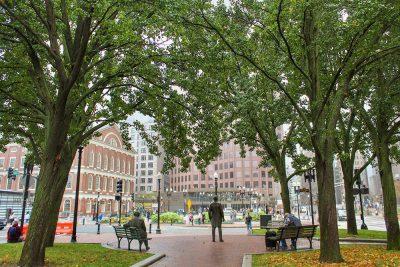
The 2022 Urban Forest Plan introduced by Mayor Michelle Wu is a plan that will create a sustainable urban tree canopy in Boston to combat heat waves and rising temperatures in the summer.
This plan seeks to invest in tree development in historically underserved areas while increasing protections for existing trees and urban forests.
To aid in preserving and expanding Boston’s tree canopy, Wu also announced in September the creation of a new Forestry Division within the Boston Parks and Recreation Department.
“Dedicating staff and resources to our new Forestry Division will empower the City of Boston to strengthen our tree canopy citywide so every community benefits from these treasured resources,” Wu said in the press release.
Numerous non-profit organizations are also dedicated to supporting Boston’s tree canopy, such as Speak for the Trees Boston and Boston Urban Forest Friends.
David Meshoulam, the co-founder and executive director of Speak for the Trees Boston, highlighted the difficulty of trying to plant trees in a city like Boston.
“Trees were not meant to grow in urban environments,” he said. “The soil is compacted. There are things like cars that bang into trees, there’s air pollution, there’s [pets] that like to relieve themselves on trees. There’s gas leaks underground that can kill trees.”
Max Ford-Diamond, Boston’s tree warden and city arborist, mentioned how much of the city’s existing trees are threatened by urban development.
“Construction is probably our number one difficulty,” Ford-Diamond said. “[Construction companies] are trying to erect a building and the trees are in conflict with that building, so they need to either cut the tree down or cut it back significantly.”
Meshoulam also highlighted construction and urban development as a major threat to Boston’s trees.
“There’s people who, for good or bad, need to remove a tree,” he said “Whether it’s for development for affordable housing, which is important, or whether it’s for expanding their porch in their backyard … There’s a lot of confounding factors that go into thinking holistically about how we grow and maintain our urban forest.”
Both Meshoulam and Ford-Diamond detailed how people can support conservation efforts within the city.
“Consider planting a tree in your yard. If there isn’t a tree on your sidewalk, call 311, ask the City to plant a tree there,” Meshoulam said. “Talk to your local city councilor and encourage them to support the growth and care of the urban forest.”
Aside from government involvement that Meshoulam encouraged, Ford-Diamond added that caring for the nearby environment can take the shape of pouring some water outside your window.
“If there’s a tree in front of your house that’s young, if you just give it some water… once a week it’ll grow and to be this nice beautiful tree that will provide shade for your house and then your heating or cooling bills could go down in the summer and winter respectively,” Ford-Diamond said. “Get involved with projects in your neighborhood to see what is going on.”
An urban tree canopy is defined by a percentage of how much of the ground is covered by trees in the city. Boston’s tree canopy is a vital part of the city’s efforts to protect the environment and reduce the effects of climate change.
“City trees can help cool pavement, buildings and help lower heating and cooling costs. They can help with stormwater runoff mitigation. They can help trap pollutants on their leaves during the year and they can help store carbon,” Ford-Diamond said.
Meshoulam explained that with environmental benefits, trees also play a major role in protecting the health of Boston’s residents.
“Trees are a really critical asset to ensure that residents can live healthy and vibrant lives,” Meshoulam said.
Last summer was declared Boston’s fourth hottest summer on record and put susceptible individuals at risk of heat related illness and death. A 2022 Boston College study estimated that air pollution causes 2,780 deaths in Massachusetts every year, almost 5% of the state’s total deaths.
The study showed Boston’s Suffolk County as having the lowest air quality in the state with an estimated 8.26 micrograms of pollution per cubic meter.
“There’s a lot to be learned and a lot of beauty that you can see,” Ford-Diamond said. “If you then appreciate it and then get involved… then you’ll actually help the environment.”






















































































































